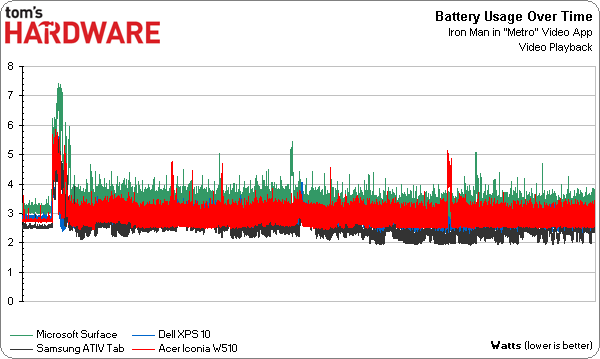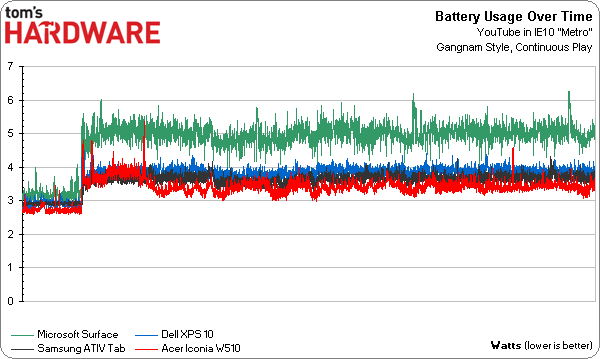Update: Intel Expands Our Battery Testing At CES 2013
We've already shown that x86 competes readily with ARM's simpler architecture when it comes to battery life. We continue our investigation at this year's CES, where Intel came packing its own tests on four current-generation tablets.
Results: Video Playback
Video: Iron Man
One thing that perpetually bothers me about battery life results generated from video playback workloads, is that they're rarely put into context. Modern SoCs include fixed-function hardware dedicated to decoding. So, a tablet’s run time while watching a movie is heavily dependent on that logic specifically. When we start measuring power consumption in this scenario, we can’t expect correlation with the previous two pages.
And indeed, the Surface doesn’t fare as badly when we play back a transcoded copy of Iron Man using the Windows 8 UI Video app.
Samsung’s implementation of the APQ8060A looks particularly strong, dipping as low as half of a watt less than the ATIV Tab’s Atom Z2760 at certain points. The lines overlap quite a bit, so it’s hard to tell, but the logged numbers show Dell’s XPS 10 using less power than the Atom much of the time, too.
This prompts the question: why do two platforms based on the same SoC demonstrate different battery power behaviors? Aside from the fact that other disparate hardware choices affect consumption, each vendor is able to tune its tablet uniquely for performance or battery life. When dealing with closed-box consumer electronics, you cannot assume that two devices based on the same components will yield identical numbers.
YouTube: Gangnam Style
As if to underscore why one video playback test won’t be indicative of another, we fully cached Gangnam Style on YouTube and logged power use as it streamed.
Get Tom's Hardware's best news and in-depth reviews, straight to your inbox.
This blended processing/video decode benchmark spins up the Tegra 3’s cores, spiking the whole platform up over 5 W and well above the competition. The Krait-based Qualcomm SoC incurs a larger hit as well. Both the Samsung ATIV Tab and Dell XPS 10 average higher consumption than the Atom-based Acer Iconia W510, which is sort of in line with what we saw from the more demanding Tom’s Hardware homepage test.
The implication is that, at idle, the ARM-based designs exhibit superior power use. As load increases, Atom appears to draw even, and eventually operates more efficiently.
Current page: Results: Video Playback
Prev Page Results: Browsing The Web Next Page Results: Average Power Use-
archange Are there any news about the 5th companion core in Tegra being supported under RT? Is software patching feasible?Reply -
abbadon_34 Please tell me the "Metro" reference in IE10 does not mean some forced Win8/Metro style interface. They've lost enough users to other browsers, do they want the rest to jump ship?Reply -
tomfreak whatever it is, 5-10hours of battery life is not good enough. 24hours is the ideal length.Reply -
archange abbadon_34Please tell me the "Metro" reference in IE10 does not mean some forced Win8/Metro style interface. They've lost enough users to other browsers, do they want the rest to jump ship?Reply
It's not "forced". On w8 you get applications specifically designed for touch input. Basically, you have two versions of IE10: the "regular" desktop one and the "Metro" version. The latter has re-placed the URL / search bar at the bottom and has larger, finger-friendly buttons. It also hides its bars for a full-screen browsing experience, which comes in handy on smaller tablet screens. Oh, and I don't use it. Dunno why, but it just doesn't appeal to me :P -
vaughn2k AMD should never had sold the (Imageon) Adreno to Qualcomm.. they should have been gaining business in the mobile business by now... Ruiz was a @*!!@$$...Reply -
ojas Also an interesting read:Reply
Anand's pre-CES article b/w Atom, Krait and the Cortex A15:
http://www.anandtech.com/show/6536/arm-vs-x86-the-real-showdown -
ojas Was interested to read about the predictions for this year.Reply
In order to get the 5-10 hours of gameplay, Tegra 4 would need to run between 3.8 and 7.6 W. We're immensely curious to see if the company can do this.
Anand estimated a 8w TDP for a quad core A15, i think it was the Exynos....with that in mind...i think you're indeed right about your estimate...
The yellow line is the time he's gaming.
Intel claims that its Haswell architecture will be exerting influence in the same space as quad-core Cortex-A15-based devices by the end of the year.
True...Ivy Bridge's already dipped to 7w... -
kyuuketsuki So... you list those 3 SoCs as defining the 2013 tablet space and completely ignore:Reply
1) Samsung's A15-based Exynos
2) AMD's Temash
The heck? -
cangelini KyuuketsukiSo... you list those 3 SoCs as defining the 2013 tablet space and completely ignore:1) Samsung's A15-based Exynos2) AMD's TemashThe heck?We didn't have that hardware on-hand in Vegas, but certainly would like to add those numbers!Reply


